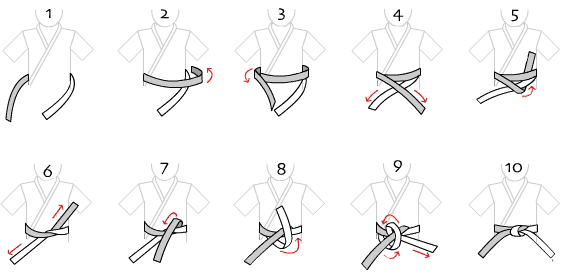Significance of Belts
There are seven belts: white, yellow, orange, green, blue, brown and black. White is given to beginners and black is given to students who have progressed through the grades and have a solid foundation for learning the techniques of Tae Kwon Do.
The definition of the belts are as follows
White Belt
The color white signifies innocence, as that of the beginning student who has no previous knowledge of Tae Kwon Do.
Yellow Belt
The color yellow signifies the earth. The beginning student begins to create a firm foundation in Tae Kwon Do technique, just as a seed begins to expand its root system deep in the earth as it begins to grow.
Orange Belt
The color orange signifies the changes of Autumn, as the student's mind and body begin to develop and grow as a result of the new Tae Kwon Do experience.
Green Belt
The color green represents growth, like that of the green plant as it sprouts out of the ground. The student has built a firm foundation and now begins to grow in the art of Tae Kwon Do.
Blue Belt
The color blue represents the sky. Reminding the student to reach for the heavens and continue their Tae Kwon Do journey.
Brown Belt
The color brown represents the ripening or maturing process as that of the advanced Tae Kwon Do student whose techniques are beginning to mature.
Black Belt
The opposite of white signifies maturity and dignity, as that of a senior student of Tae Kwon Do who has learned the basic curriculum of Tae Kwon Do and is ready to become a true student of Tae Kwon Do.
One of the greatest misconceptions within the martial arts is the notion that all black belt holders are experts. It is understandable that those unacquainted with the martial arts might make this equation.
However, students should certainly recognize that this is not always the case. Too often, novice black belt holders advertise themselves as experts and eventually even convince themselves.
The first degree black belt holder has usually learned enough techniques to defend himself against a single opponent. He can be compared to a fledgling who has acquired enough feathers to leave the nest and fend for himself. The first degree is a starting point. The student has merely built a foundation. The job of building the house lies ahead.
The novice black belt holder will now really begin to learn technique. Now that he has mastered the alphabet, he can begin to read. Years of hard work and study await him before he can even begin to consider himself an instructor and expert. A perceptive student will, at this stage, suddenly realize how very little he knows.
The black belt holder also enters a new era of responsibility. Though a freshman, he has entered a strong honorable fraternity of the black belt holders of the entire world: and his or her actions inside and outside the training hall will be carefully scrutinized. His conduct will reflect on all black belt holders and he must constantly strive to set an example for all grade holders.
Some will certainly advance into the expert stages. However, far too many will believe the misconception and will remain novice, mentally and technically.
Belt Ranking
| White Belt | |||||||
| Yellow Belt - Low | |||||||
| Yellow Belt - High | |||||||
| |
Orange Belt - Low | ||||||
| Orange Belt - High | |||||||
| Green Belt - Low | |||||||
| |
Green Belt - High | ||||||
| |
Blue Belt - Low | ||||||
| Blue Belt - High | |||||||
| Brown Belt - 3rd Temporary | |||||||
| Brown Belt - 3rd Permanent | |||||||
| Brown Belt - 2nd Temporary | |||||||
| Brown Belt - 2nd Permanent | |||||||
| Brown Belt - 1st Temporary | |||||||
| Brown Belt - 1st Permanent | |||||||
| |
Temporary Black Belt | ||||||
| |
Black Belt | ||||||
Tying A Belt
